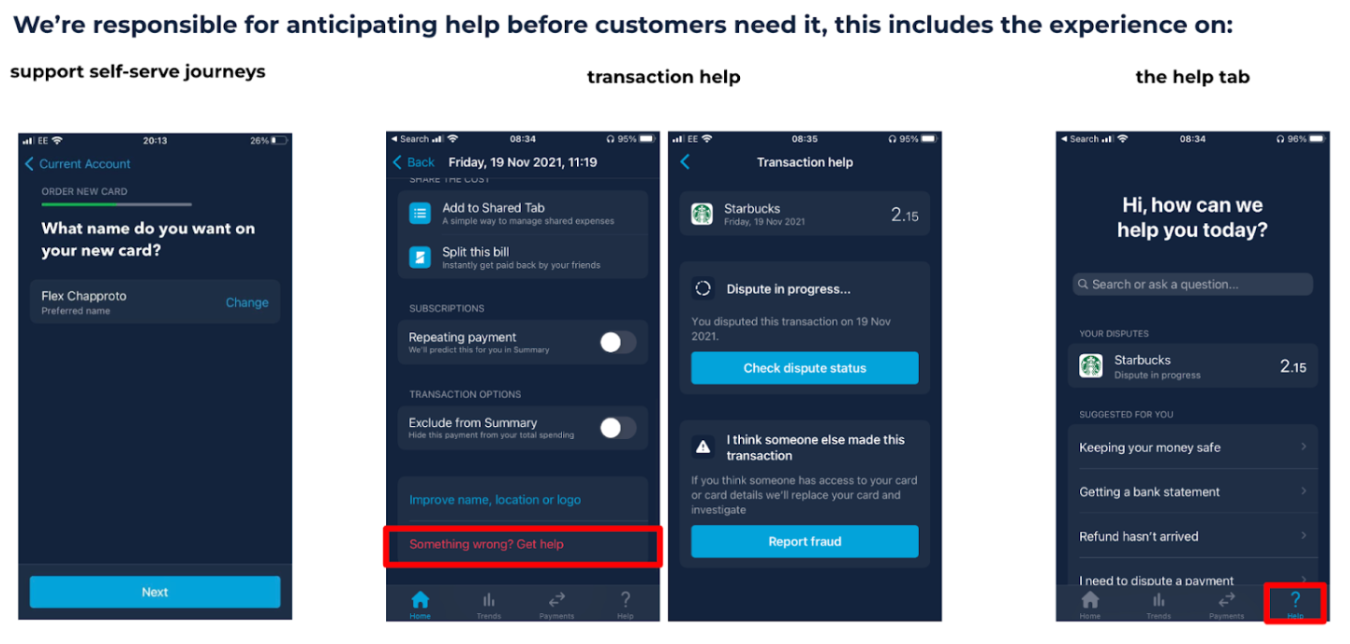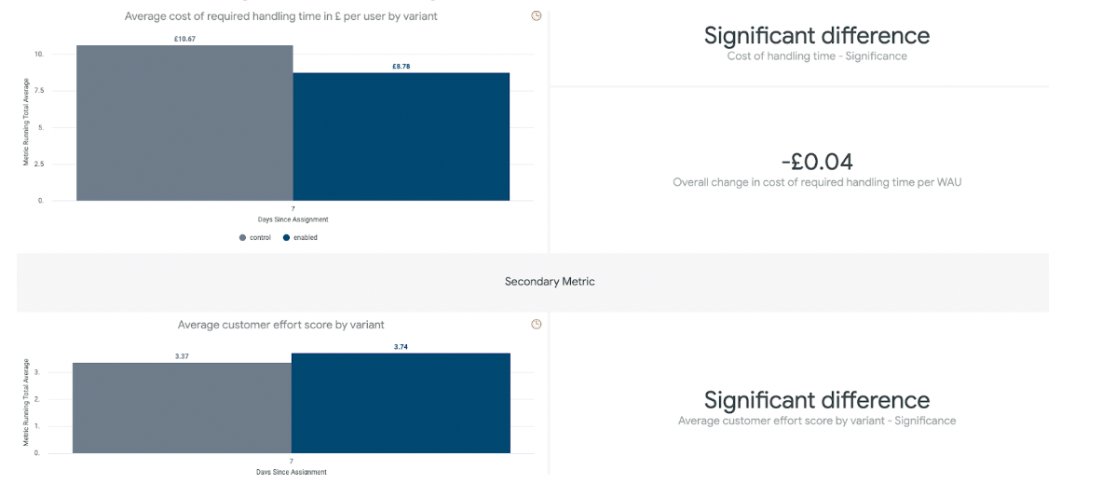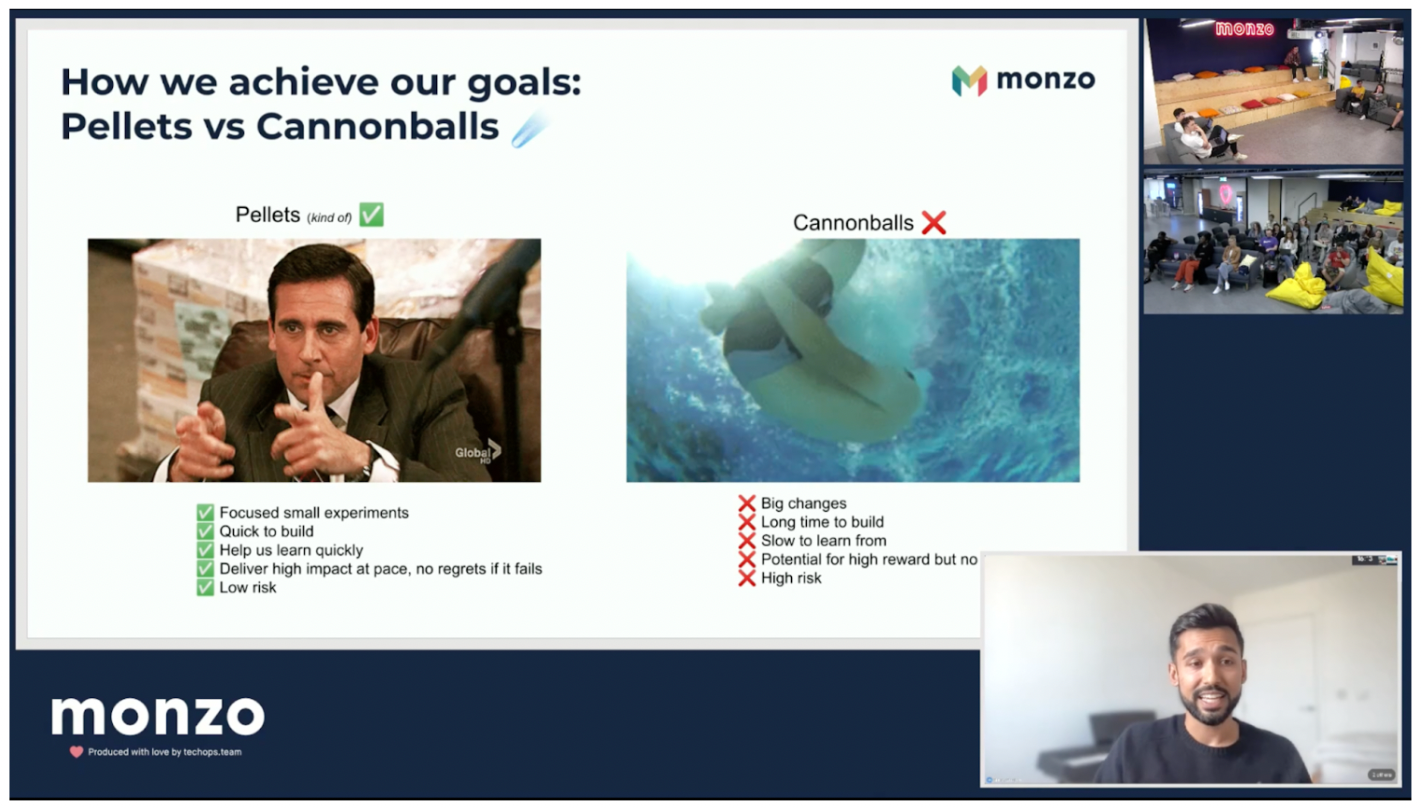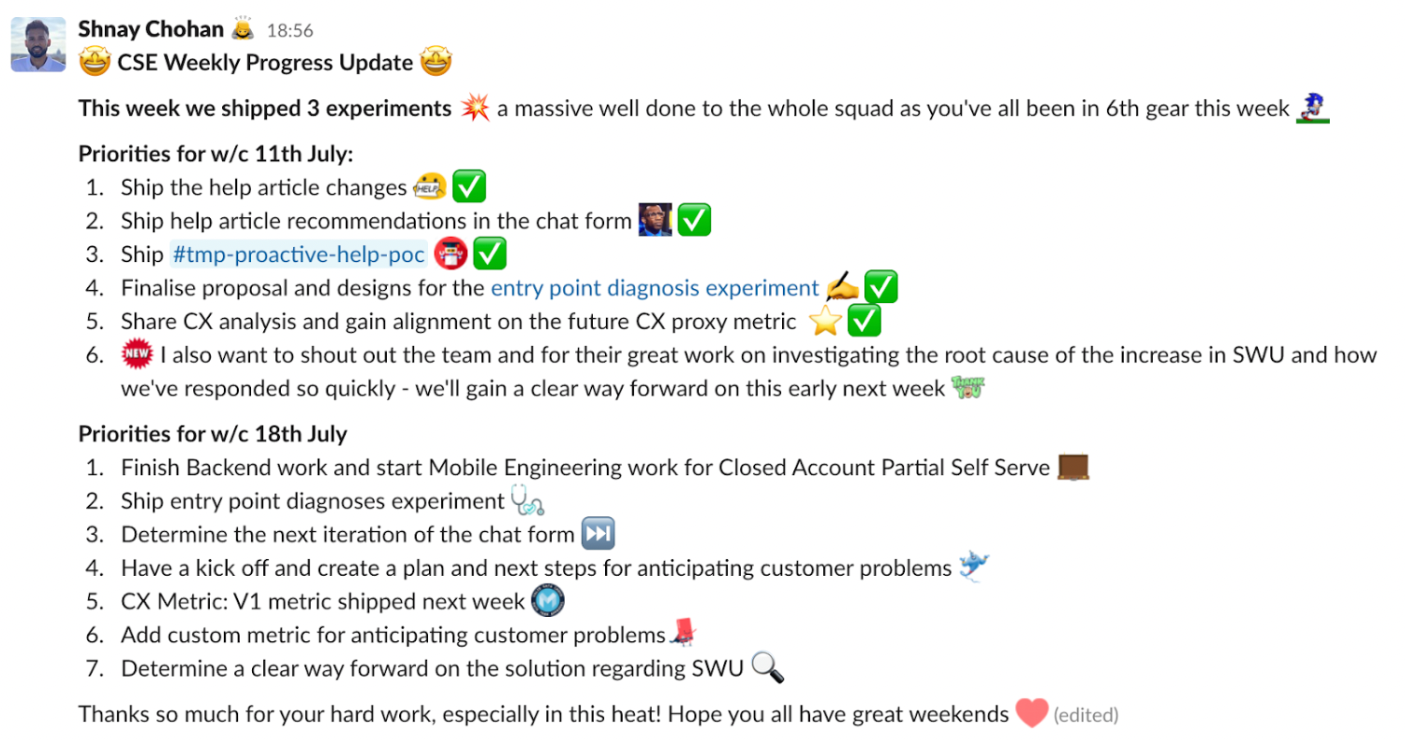I’m Shnay, a Senior Product Manager (PM) at Monzo for the Customer Support Experience Squad. We’re responsible for the help and support experience in the app, which includes self-serve journeys, transaction help, and the help tab.
Fellow product manager Tim recently shared a post on his first 3 months as a PM at Monzo. I’m often asked by Product Managers outside of Monzo what a typical week looks like so in this post I’ll give an insight into what life is like as a PM here. It’s by no means perfect and I’m always looking to learn and improve!
The role of product managers at Monzo
A PM is a well-trusted role and a key player at Monzo. We aim to identify and build products for customer needs that align with the company’s goals. This means looking after the entire product lifecycle, being heavily involved in the building of products and the strategy. We help decide on the most impactful products to build with teams, then enable those teams to deliver as best and quickly as possible.
My squad and our current projects
The Customer Support Experience squad sits within the Operations Collective at Monzo. We’re responsible for helping customers with any problems they have, from when they open the app until they speak to a human. We exist to deliver world-class customer support by using data to anticipate customer needs and problems as soon as we can. The squad is made up of an engineering manager, backend engineers, data scientists, machine learning engineers, research, design, and customer operations partners.
At Monzo, we work towards goals every half of the year. Our current focus area is the chat and help experience on the app.

We have an existing roadmap which we built in March 2022 as part of the half-year kick-off. This process (which could probably be its own blog post) consists of:
building context and deeply understanding the problem space (chat and help)
understanding the customer through shadowing our Customer Operations team (COps) who directly interact with customers
identifying the key opportunities and writing proposals including technical feasibility and impact assessments
prioritising experiments
This process resulted in our roadmap which details which experiments we plan to run, what impact we expect from them, and when we will run them.
This half year we’ve focused on smaller iterative experiments that can mostly be shipped in a week, rather than building a zero-to-one product. We’re also thinking about the next half goal planning, so you’ll see this theme throughout the week.
A typical week
I’ll go through some of the key activities you could expect to be within a typical week. I like framing in themes, so I’ve decided to add a theme song to each day to help bring this to life.
I try to bring my best self to work every day. That means putting myself first and ensuring I have a good start. My morning routine consists of drinking coffee, meditating, hitting the gym, and having a cold shower before starting my work day.
Monday: Check-in & planning
Theme song: Get Up And Drive Your Funky Soul - James Brown
It’s the first day of the week so I try to make sure the squad is clear on what our goals and priorities are for the days ahead, unblocking and empowering them as much as possible. I also try to check in with the other PMs in the Ops Collective to see if there’s anything I can help them with.
Weekly planning
I work with the domain leads from UX, tech and data the week before to ensure we’re aligned on priorities and communicate those priorities with the team before planning.
We start by celebrating what we achieved last week. We then remind ourselves of the weekly goals and allow everyone to challenge whether they are the right weekly priorities before jumping into our JIRA board. Our priorities are already set up as epics on JIRA, so we create the tickets that sit underneath and articulate the steps required to achieve our weekly goals.
Given we already have our defined roadmap and we’re in shipping mode, weekly planning is about making it clear what pieces of work will be shipped next. It’s an opportunity to provide clarity and direction to the squad, empowering them to make decisions autonomously and move closer to the squad goals.

If I find myself having to make lots of small decisions it means I am not empowering my team enough, or that I’m not communicating the vision and context well enough. I regularly remind myself of this to ensure that we have a team of missionaries as opposed to mercenaries.
I have separate catch-ups with my Tech Lead and my PM Director. Given the time of year these discussions are largely focused on goal setting and planning for the next half of the year.
Weekly Tech Lead sync
A Tech Lead is a key decision maker for technical changes in the squad. They make sure all team members understand and follow important technical decisions.
We discuss bold bets we could make for the next half of the year. We also have mobile engineers joining our squad soon so we discuss what they will work on when they land in our squad. We decide to do a whiteboard session with a slightly wider group later in the week to nail both of these down.
Desired outcome:
Shortlist bold bets for the next half year to be explored further with the team
Brainstorm experiments for mobile engineers to immediately work on when they land in the squad for the next few weeks
Weekly PM Director sync
A PM Director is responsible for an entire product org, or multiple product lines, and is responsible for guiding the collective level product strategy.
This is a meeting to share updates, flag issues and discuss product strategy. We end up with a plan to unblock or solve issues, alignment, and next steps on product strategy discussions.
Remainder of day
I’ll then spend the rest of the day scanning through the data for ongoing experiments, looking ahead at the next set of experiments we want to run, and reading through and commenting on proposals. At Monzo we use proposals to communicate ideas and share context, the proposals I reviewed were for experiments our squad could run.
Tuesday: Deep dive day
On Tuesdays, I like to spend time diving deep into data, designs, and proposals
Experiments deep dive
I will go through each of our live experiment dashboards trying to understand:
How well they are performing vs what we estimated
How much longer is needed for them to reach statistical significance
Whether there are any actionable insights and future iterations we should build
Here’s an example of our experiment dashboard:

In this example we’ve increased our customer effort score as well as saved costs, which is the ideal outcome we want to achieve for our experiments.
Further data deep dive
I then go through our main dashboards looking at the biggest opportunities that we can go after, I create hypotheses on why they are our biggest opportunities and then dive deeper into a few areas.
I review customer conversations to try to understand whether I can quickly validate the hypothesis based on what I’m seeing in the chats. We have lots of proposals created for big opportunity areas which we did earlier in the year, so I find myself often going back and forth between the data and proposals to make sure I fully understand the problem. If I think I’ve found something which hasn’t been considered I’ll write up a mini proposal and share it early with my Tech Lead and Design Lead for feedback.

Weekly design sync
Our Senior Designer is fantastic at cutting through complexity with simple and effective design. I use this time to gain a different perspective on solutions to the problems we’re trying to solve.
Purpose:
Review specific designs and provide feedback for our next set of experiments
Clarify the priorities from a design perspective over the next few weeks
Discuss and gain feedback on H2 draft goals
Desired outcome:
Product inputs received on designs for the next set of experiments
We’re aligned on priorities for the next few weeks
Design inputs received on the next draft goals
Weekly data sync
As a PM I rely heavily on my Data Scientist at all stages of the product lifecycle from ideas all the way through to post implementation analysis of changes we’ve shipped.
Purpose:
Share findings from my data deep dive and validate or invalidate hypotheses
Receive new insights and analysis on opportunities for improvement that the Data Scientist has proactively been working on
Share proposals to validate the estimated impact associated with them
Discuss and seek feedback on draft goals for the next half of the year and how best to measure their success
Receive an update on ‘how to better measure customer experience’ strategic initiative is going
Desired outcome:
Determine whether the findings in my data deep dive are valid or invalid
Validate the estimated impact of future proposals
Data inputs received on the next half’s draft goals
Understand the progress made on ‘how to better measure customer experience’, the next steps, and how I can best support
Engineering Manager async check-in
An Engineering Manager’s role at Monzo is to provide support and technical leadership for teams. They manage the engineers and are largely responsible for the efficiency of the squad.
When I first started my role I was heavily reliant on the engineering manager. He helped to ensure our rituals were the most optimal and our roadmap was achievable with the people we had in the squad. We now have a great rhythm as a squad and usually check-in async. He’ll ask how the team is doing, for example to check if there is any feedback to address from our retro, if there’s anything I need support on, and give me a heads up on any changes I should be aware of.
Research sync
Our researcher sits across all of the squads within the Ops Collective. We spend a lot of time talking about vision and how the Customer Support Experience Squad ties into the overall strategic vision of Operations and Monzo. To read more about researching operations at Monzo, check out his blog post. Often these meetings can happen async, he’ll usually share a proposal for me to read and feedback on and vice versa.
Purpose:
Gain a better understanding of the various streams of work happening across the different squads within Operations, as our researcher works across multiple squads
Discuss vision, goal setting, and planning for the second half of the year and beyond
Make the researcher aware of our priorities and where we need research support over the coming months
Desired outcome:
Align on how the work we’re doing in our squad fits well with other squads across the collective
Be aware of any work across the Operations Squads that will affect our squad
Align on the wider vision for Operations and our squads’ role in achieving the vision
Input to the research priorities over the coming months
Customer Operations Partner sync
A COps Partner is the glue between Operations and the Product Squads. They ensure that the Operations Team are aware of the changes and how they are impacted, in addition, they understand our current processes end to end better than anyone else.
Purpose:
To gain input on proposals from an operations perspective i.e. what’s the current process of closing an account; is there anything we haven’t considered based on this proposal?
Further validate hypotheses based on the findings from the data deep dive earlier
Desired outcome:
Gain confidence that our proposals and next set of experiments will have the desired impact
I arrive at the end of the day with much more clarity on our short-term and longer-term goals, a better understanding of the customer, and more alignment with the rest of the squad.
Wednesday: Product Review & Strategy
Theme song: Daft Punk - Harder, Better, Faster, Stronger
I use our daily stand-up to check in on progress mid-week vs our priorities for the week
Interviewing
In Monzo we’re growing rapidly, so I spend a few hours a week interviewing. This is an important role for a PM to help the future success of Monzo and also a great opportunity to work closely with other PMs and senior people from across the business.
Product review
The goal of tactical product reviews is to help us advance better product work, faster.
This will typically be through reviewing progress against goals, diving into the implementation and designs, getting challenged on execution, sharing changing circumstances, or unblocking key tactical decisions.
In this particular review, I remind the leadership of our goals and vision, share our progress vs goals and the next set of experiments we are shipping, sharing designs on what we’re planning on shipping to customers for feedback and input.
Monzo Connect
Monzo Connect is a company wide monthly optional meeting which features spotlights and updates from around the company. This week I am presenting on the future of The Future of Chat and Help. I presented our approach to Product and how we experiment in our squad using Pellets vs Cannonballs and then talked through some upcoming experiments and how they will transform the chat and help experience for customers. This gives visibility on what our squad is working on across the company and allows me to share some of the best practices from our squad that other PMs and Collectives can use.

Thursday: Reflect and project
Theme song: Kanye West - Power
I usually go to the office on Thursday and I use this day to think about the week ahead, reflect on the last few weeks, and sync with my Leads on priorities for next week.
Power hour
Before we ship changes we have a power hour where some members of the squad come together to test the changes in our staging app that we’re looking to implement for customers. The aim is to find bugs and ensure that it’s working as expected. Once we’ve gone through the key journeys we note down the bugs or improvements in JIRA and then prioritise what we believe must happen before shipping and what is a nice to have that we can save for a later iteration.
Retrospective
We have a retro every two weeks to reflect on how things are going as a squad. What’s going well? What could be improved? And what still puzzles us? We take some clear actions on the back of it.
Machine Learning Operations huddle
This is a meeting between the machine learning engineers and the product managers across the Operations Collective.
We discuss the key initiatives happening across the operations and think about how machine learning can play a part in accelerating us towards our goals.
We used the meeting to discuss the bigger vision of the Customer Support Experience squad and how machine learning fits into this. The key action was to break down the machine learning work into smaller experiments, phases and next steps to create a proposal which we can give feedback on async.
PM weekly meeting
We have a weekly meeting where all of the PMs come together. We typically rotate the hosts of the meeting and they can decide how the session is run. Usually, we decide on a topic to talk about i.e. what’s a problem you’re facing as a PM at the moment? and we’ll jump into breakout rooms to talk about them in more detail, getting advice from each other on how to solve the problem.
Leads sync
I have a weekly sync with the Leads from Design, Tech, Data, and Operations. I typically start by proposing what I think should be prioritised for the next week based on our roadmap and then discuss it during the sync. We end the meeting having a clear idea of what’s the priority for the following week and use the rest of the time to talk about any other team-related topics.
Whiteboard session
A useful way to spend time at the office is through whiteboard sessions. So with the Tech Lead, Senior Designer, and Researcher, we spent time breaking down our goals for the next half and the rest of the meeting determining what we want our Mobile Engineers to work on. We try to keep the meetings relatively fluid to allow the creative juices to flow. We came away with a prioritised list of what we want our mobile engineers to work on and the next steps required for our goals for the next half.
Friday: No meetings Fridays
We have no meeting Fridays across Monzo. I try to stick to this as much as possible as this is a really valuable time to be able to get work across the line and set up for success in the weeks ahead. I usually send a weekly update on how the team has performed and share priorities for the upcoming week:

This Friday my time is spent on determining the rest of the experiments we will do in this half of the year. I’ll also draft a strategy document on what we will do in the next half and get early feedback from the team. Some of the themes I will include are:
Writing our north star vision as a squad and detailing my perspective on what I think it means
Clarifying the next half’s goals
Detailing the problem we’re trying to solve
Outlining how I think we should solve it
Reflecting on what went well and what didn’t go well in the last 6 months
Outlining what good looks like in the next half
Clarifying what is descoped for the half
I then look to tie any loose ends before the end of the week and ensure my calendar aligns well with the squads priorities for next week.
A varied week!
A week varies significantly, however, the thing I keep in mind is how I can enable and empower my team to achieve our shorter and longer-term goals. You’ll find that every PM's week looks different across Monzo. There’s no one right way to do things and it very much depends on the context and skillset of the squad. We've found a good rhythm that seems to work well for us at the moment based on our current goals, but I know that we need to be flexible and adaptable as things move fast and are always evolving.
I hope this post gave you some insight into how Product Managers work at Monzo. We can’t do this alone though, so if you like the sound of what we do and how we work, join us! We’re looking for even more product managers to join our crew.